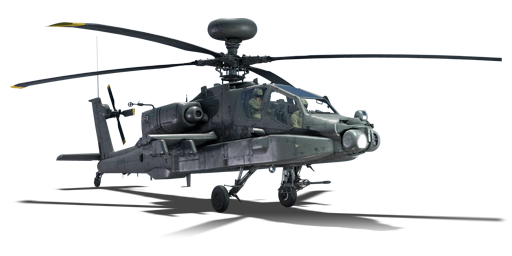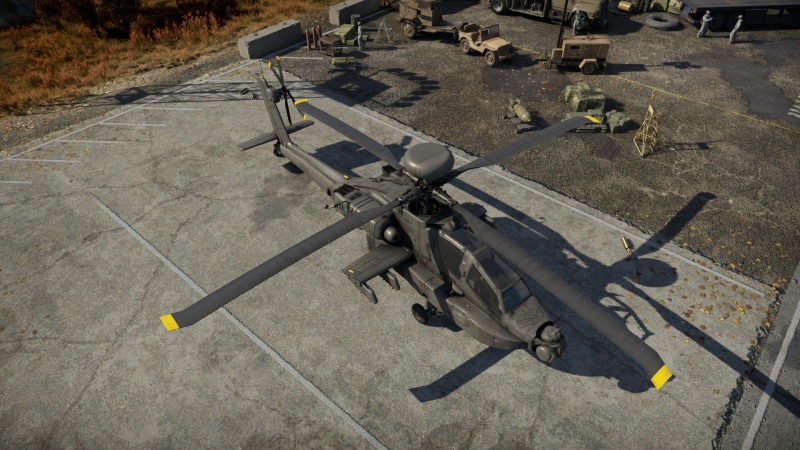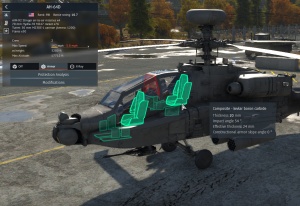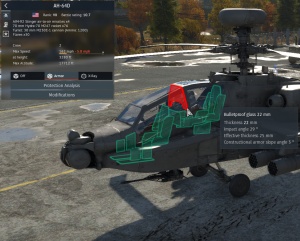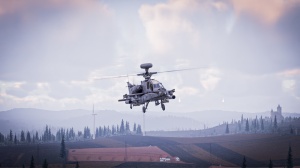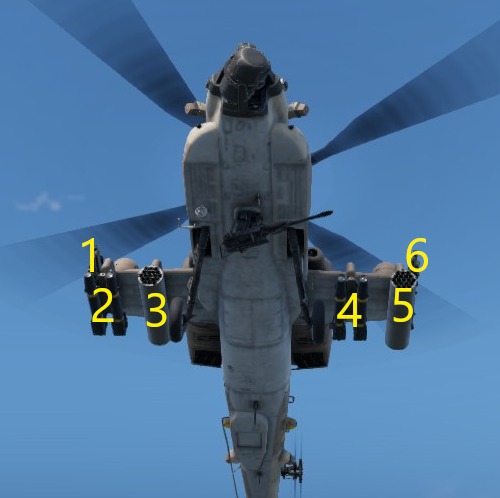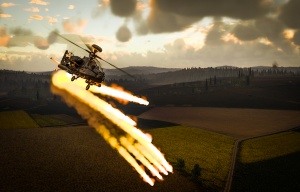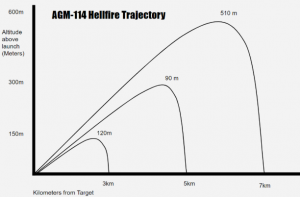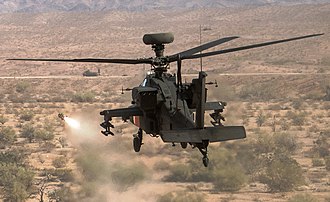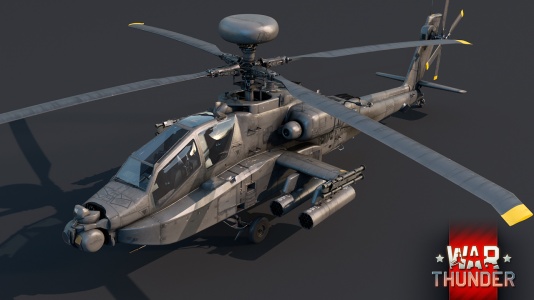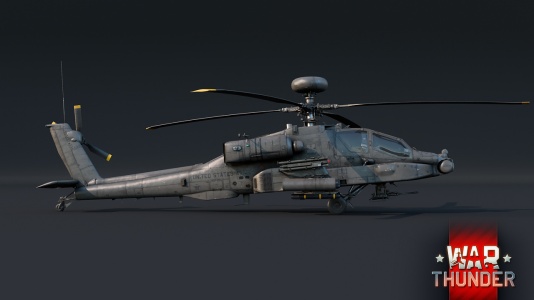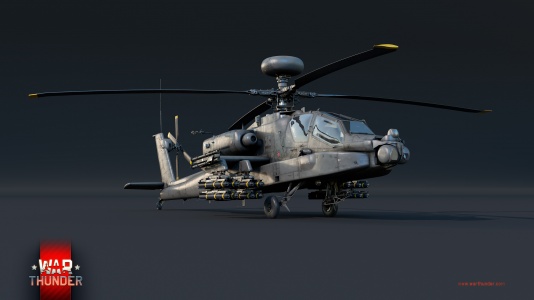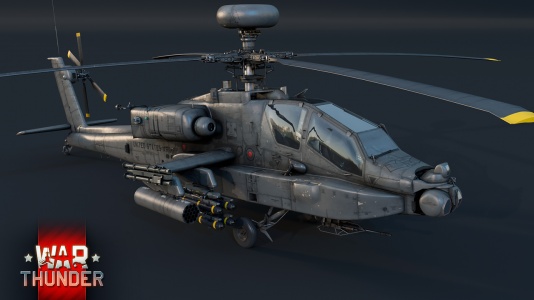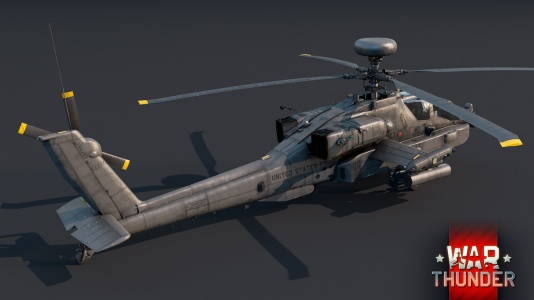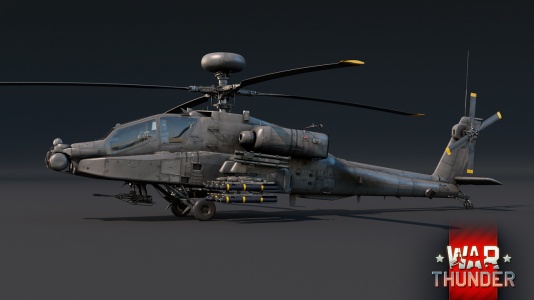Difference between revisions of "AH-64D"
CobraKingII (talk | contribs) (→See also) |
Colok76286 (talk | contribs) (Undo revision 182397 by U126949070 (talk)) |
||
| (32 intermediate revisions by 14 users not shown) | |||
| Line 1: | Line 1: | ||
| − | {{Specs-Card|code=ah_64d}} | + | {{About |
| + | | about = American attack helicopter '''{{PAGENAME}}''' | ||
| + | | usage = other versions | ||
| + | | link = AH-64 (Family) | ||
| + | }} | ||
| + | {{Specs-Card | ||
| + | |code=ah_64d | ||
| + | |images={{Specs-Card-Image|GarageImage_{{PAGENAME}}.jpg}} | ||
| + | }} | ||
== Description == | == Description == | ||
<!-- ''In the description, the first part should be about the history of and the creation and combat usage of the helicopter, as well as its key features. In the second part, tell the reader about the helicopter in the game. Insert a screenshot of the vehicle, so that if the novice player does not remember the vehicle by name, he will immediately understand what kind of vehicle the article is talking about.'' --> | <!-- ''In the description, the first part should be about the history of and the creation and combat usage of the helicopter, as well as its key features. In the second part, tell the reader about the helicopter in the game. Insert a screenshot of the vehicle, so that if the novice player does not remember the vehicle by name, he will immediately understand what kind of vehicle the article is talking about.'' --> | ||
| − | + | Following studies done in the late 1980's on the AH-64A/B Apache, and funding in 1991, the US army began to look at upgrading their existing fleet of aircraft, leading to the AH-64B+ and the subsequent '''{{Specs|name}}''' "Apache Longbow". Featuring the newer AN/APG-78 "Longbow" mast-mounted fire control radar (FCR) as well as upgraded avionics and weaponry, the '''{{Specs|name}}''' is a formidable attack helicopter and successor to the AH-64A. | |
| − | {{ | + | |
| − | The '''{{Specs|name}}''' is a rank {{Specs|rank}} American attack helicopter {{Battle-rating}}. It was introduced in [[Update 1.97 "Viking Fury"]]. | + | The '''{{Specs|name}}''' is a rank {{Specs|rank}} American attack helicopter {{Battle-rating}}. It was introduced in [[Update 1.97 "Viking Fury"]]. Although lacking the AIM-9Ls found on its predecessor, the '''{{Specs|name}}''' can carry up to 16 AGM-111K Hellfire II missiles. |
== General info == | == General info == | ||
=== Flight performance === | === Flight performance === | ||
| − | <!--''Describe how the helicopter behaves in the air. Speed, manoeuvrability, acceleration and allowable loads - these are the most important characteristics of the vehicle.''--> | + | {{Specs-Heli-Flight}} |
| − | The AH-64D Longbow, provides great manoeuvrability, incredible acceleration and overall providing a great speed of up to 319 km/h in arcade and 295 km/h in realistic and simulator game modes. It is fast as the | + | <!-- ''Describe how the helicopter behaves in the air. Speed, manoeuvrability, acceleration and allowable loads - these are the most important characteristics of the vehicle.'' --> |
| + | The AH-64D Longbow, provides great manoeuvrability, incredible acceleration and overall providing a great speed of up to 319 km/h in arcade and 295 km/h in realistic and simulator game modes. It is as fast as the Japanese [[AH-64DJP]] but the title of fastest AH-64D belongs to the British Army variant called the [[AH Mk.1]]. The U.S. Army AH-64D Longbow is able to do manoeuvres other helicopters can only dream about, from barrel roles, flips to loops. Which allow it to evade enemy missiles with ease and surprise, poor enemy tankers who will be helpless to defeat it. | ||
{| class="wikitable" style="text-align:center" | {| class="wikitable" style="text-align:center" | ||
| Line 21: | Line 30: | ||
|- | |- | ||
! Stock | ! Stock | ||
| − | |271||253|| rowspan="2" | | + | | 271 || 253 || rowspan="2" | {{Specs|ceiling}} |
|- | |- | ||
! Upgraded | ! Upgraded | ||
| − | |319||295 | + | | 319 || 295 |
|- | |- | ||
|} | |} | ||
=== Survivability and armour === | === Survivability and armour === | ||
| − | <!--''Examine the survivability of the helicopter. Note how vulnerable the structure is and how secure the pilot is, whether the fuel tanks are armoured, etc. Describe the armour, if there is any, and also mention the vulnerability of other critical systems.''--> | + | [[File:AH-64D Armor Values.jpg|thumb|300px|Kevlar boron carbide armour on AH-64D]] |
| − | The AH-64D Apache longbow, has only limited armour protection installed with bullet proof glass only being installed on the pilot windscreen. The helicopter uses Kevlar boron carbide, composite martial which is limited only to instrument, floor and side panels around the cockpit. It does not provide the same level of protection as seen on other helicopters such as the | + | [[File:AH-64D Bulletproof Glass Stats.jpg|thumb|300px|Bulletproof glass armour rating]] |
| + | {{Specs-Heli-Armour}} | ||
| + | <!-- ''Examine the survivability of the helicopter. Note how vulnerable the structure is and how secure the pilot is, whether the fuel tanks are armoured, etc. Describe the armour, if there is any, and also mention the vulnerability of other critical systems.'' --> | ||
| + | The AH-64D Apache longbow, has only limited armour protection installed with bullet proof glass only being installed on the pilot windscreen. The helicopter uses Kevlar boron carbide, composite martial which is limited only to instrument, floor and side panels around the cockpit. It does not provide the same level of protection as seen on other helicopters such as the [[Mi-28N]]. | ||
| − | * Bullet proof glass installed only for the pilot - 22 mm thick. | + | * Bullet proof glass installed only for the pilot - 22 mm thick. |
* Installation of Kevlar boron carbide, composite martial only on the: Seats, cockpit side panels, Gunner floor panels and pilot instrument panel - 20 mm thick. | * Installation of Kevlar boron carbide, composite martial only on the: Seats, cockpit side panels, Gunner floor panels and pilot instrument panel - 20 mm thick. | ||
| + | |||
| + | === Modifications and economy === | ||
| + | {{Specs-Economy}} | ||
== Armaments == | == Armaments == | ||
| + | {{Specs-Heli-Armaments}} | ||
| + | [[File:AH-64D Defender.jpg|thumb|300px|AH-64D in Fulda]] | ||
| + | {| class="wikitable" style="text-align:center" | ||
| + | |- | ||
| + | ! colspan="3" | [[Ballistic Computer]] | ||
| + | |- | ||
| + | ! CCIP (Guns) !! CCIP (Rockets) !! CCIP (Bombs) | ||
| + | |- | ||
| + | | {{Tick}} || {{Tick}} || {{Cross}} | ||
| + | |- | ||
| + | |} | ||
=== Offensive armament === | === Offensive armament === | ||
| + | {{Specs-Heli-Offensive}} | ||
<!-- ''Describe the offensive armament of the helicopter, if any. Describe how effective the cannons and machine guns are in battle, also what ammunition belts or drums are better to use. If there is no offensive weaponry, delete this subsection.'' --> | <!-- ''Describe the offensive armament of the helicopter, if any. Describe how effective the cannons and machine guns are in battle, also what ammunition belts or drums are better to use. If there is no offensive weaponry, delete this subsection.'' --> | ||
| − | {{main | + | {{main|M230E-1 (30 mm)}} |
The '''''{{PAGENAME}}''''' is armed with: | The '''''{{PAGENAME}}''''' is armed with: | ||
| − | + | * 1 x 30 mm M230E-1 cannon, chin turret (1,200 rpg) | |
| − | + | * 30 x countermeasures | |
| − | * | ||
=== Suspended armament === | === Suspended armament === | ||
| + | {{Specs-Heli-Suspended}} | ||
<!-- ''Describe the helicopter's suspended armament: additional cannons under the winglets, any bombs, and rockets. Since any helicopter is essentially only a platform for suspended weaponry, this section is significant and deserves your special attention. If there is no suspended weaponry remove this subsection.'' --> | <!-- ''Describe the helicopter's suspended armament: additional cannons under the winglets, any bombs, and rockets. Since any helicopter is essentially only a platform for suspended weaponry, this section is significant and deserves your special attention. If there is no suspended weaponry remove this subsection.'' --> | ||
| − | |||
The '''''{{PAGENAME}}''''' can be outfitted with the following ordnance: | The '''''{{PAGENAME}}''''' can be outfitted with the following ordnance: | ||
| + | {| class="wikitable" style="text-align:center" width="100%" | ||
| + | |- | ||
| + | ! !! width="7%" | 1 !! width="7%" | 2 !! width="7%" | 3 !! width="7%" | 4 !! width="7%" | 5 !! width="7%" | 6 | ||
| + | | rowspan="7" width="25%" | <div class="ttx-image">[[File:Hardpoints_AH-64A_(Israel).png]]</div> | ||
| + | |- | ||
| + | ! [[Hydra-70 M247]] rockets | ||
| + | | || 19 || 19 || 19 || 19 || | ||
| + | |- | ||
| + | ! [[AGM-114K Hellfire II]] missiles | ||
| + | | || 2, 4 || 2, 4 || 2, 4 || 2, 4 || | ||
| + | |- | ||
| + | ! [[APKWS II (M151)]] missiles | ||
| + | | || 7 || 7 || 7 || 7 || | ||
| + | |- | ||
| + | ! [[APKWS II (M282)]] missiles | ||
| + | | || 7 || 7 || 7 || 7 || | ||
| + | |- | ||
| + | ! [[ATAS (AIM-92)]] missiles | ||
| + | | 2 || || || || || 2 | ||
| + | |- | ||
| + | ! Countermeasures | ||
| + | | 60 || || || || || 60 | ||
| + | |- | ||
| + | | colspan="8" | * Both countermeasure pods must be equipped together | ||
| + | |} | ||
| + | |||
| + | {{Navigation-Start|Default weapon presets}} | ||
| + | {{Navigation-First-Simple-Line}} | ||
| + | * Without load | ||
| + | * 4 x ATAS (AIM-92) missiles | ||
* 76 x Hydra-70 M247 rockets | * 76 x Hydra-70 M247 rockets | ||
| + | * 28 x APKWS II (M151) missiles | ||
| + | * 28 x APKWS II (M282) missiles | ||
| + | * 4 x AGM-114K Hellfire II missiles | ||
* 8 x AGM-114K Hellfire II missiles | * 8 x AGM-114K Hellfire II missiles | ||
| − | |||
| − | |||
* 16 x AGM-114K Hellfire II missiles | * 16 x AGM-114K Hellfire II missiles | ||
| + | * 120 x countermeasures | ||
| + | {{Navigation-End}} | ||
=== Defensive systems === | === Defensive systems === | ||
| − | <!--''Defensive armament with turret machine guns or cannons, crewed by gunners. Examine the number of gunners and what belts or drums are better to use. If defensive weaponry is not available, remove this subsection.''--> | + | <!--''Defensive armament with turret machine guns or cannons, crewed by gunners. Examine the number of gunners and what belts or drums are better to use. If defensive weaponry is not available, remove this subsection.''--> |
| − | The '''''{{PAGENAME}}''''' | + | [[File:AH-64D Countermeasures.jpg|thumb|300px|AH-64D dispenses flare series as a countermeasure against heat-seeking missiles.]] |
| + | The '''''{{PAGENAME}}''''' has the following defensive systems installed: | ||
| − | *''' | + | *'''Countermeasures''' - Up to 150 countermeasures can be installed. |
| − | |||
*'''AMASE''' - Apache Modular Aircraft Survivability Equipment. | *'''AMASE''' - Apache Modular Aircraft Survivability Equipment. | ||
| − | *'''AIM- | + | *'''AIM-92 Stinger''' - AIM 92 Stinger missiles |
| − | When unlocked, | + | When unlocked, countermeasures are not installed - this requires the Flares/Chaff module (tier I) to be researched and installed, this provides up to 30 countermeasures. The next module called AMASE (tier II) provides up to 150 countermeasures, the additional 120 countermeasures are installed on the wingtips of the helicopter. Then the last module called AIM-92 Stinger (tier III) allows for the installation of a maximum of four AIM-92 Stinger missiles, which two are mounted on each wing tip. |
== Usage in battles == | == Usage in battles == | ||
<!-- ''Describe the tactics of playing in a helicopter, the features of using the helicopter in a team and advice on tactics. Refrain from creating a "guide" - do not impose a single point of view, but instead, give the reader food for thought. Examine the most dangerous enemies and give recommendations on fighting them. If necessary, note the specifics of the game in different modes (AB, RB, SB).'' --> | <!-- ''Describe the tactics of playing in a helicopter, the features of using the helicopter in a team and advice on tactics. Refrain from creating a "guide" - do not impose a single point of view, but instead, give the reader food for thought. Examine the most dangerous enemies and give recommendations on fighting them. If necessary, note the specifics of the game in different modes (AB, RB, SB).'' --> | ||
| − | '''Overview | + | '''Overview''' |
The AH-64D is very similar to the [[AH-64A]] Apache. The differences are the lack of an option to carry AIM-9L missiles, the new Longbow radar, improved Hellfires, and an improved ECM package. The Apache is an excellent helicopter for attacking ground targets, and can also hold its own against many enemy aircraft. Through adequate use of cover, teamwork, and game sense, the Apache can easily dismantle enemy teams. An Apache pilot must understand all of the tools at their disposal. | The AH-64D is very similar to the [[AH-64A]] Apache. The differences are the lack of an option to carry AIM-9L missiles, the new Longbow radar, improved Hellfires, and an improved ECM package. The Apache is an excellent helicopter for attacking ground targets, and can also hold its own against many enemy aircraft. Through adequate use of cover, teamwork, and game sense, the Apache can easily dismantle enemy teams. An Apache pilot must understand all of the tools at their disposal. | ||
| Line 78: | Line 137: | ||
The Apache has an arsenal of weapons. The most effective anti-tank weapon in the Apache's arsenal is the AGM-114 Hellfire, which uses a top attack trajectory to destroy ground vehicles. There is functionally very little difference between the AGM-114B and K variants, used on early and late Apaches respectively. | The Apache has an arsenal of weapons. The most effective anti-tank weapon in the Apache's arsenal is the AGM-114 Hellfire, which uses a top attack trajectory to destroy ground vehicles. There is functionally very little difference between the AGM-114B and K variants, used on early and late Apaches respectively. | ||
| − | '''Staying | + | '''Staying alive:''' |
Flying the Apache effectively can be more difficult than most players would imagine, processing information from optical sights, radar displays, and the radar warning receiver all at once can lead to information overload. If distracted by irrelevant information, a pilot can quickly lose situational awareness. Being successful in the Apache requires situational awareness above all else. Due to the fragility of the helicopter, any blindspot can lead to a quick and sudden death. Additionally, the mobility of the Apache is adequate but not impressive, so evasive manoeuvres are not always effective. | Flying the Apache effectively can be more difficult than most players would imagine, processing information from optical sights, radar displays, and the radar warning receiver all at once can lead to information overload. If distracted by irrelevant information, a pilot can quickly lose situational awareness. Being successful in the Apache requires situational awareness above all else. Due to the fragility of the helicopter, any blindspot can lead to a quick and sudden death. Additionally, the mobility of the Apache is adequate but not impressive, so evasive manoeuvres are not always effective. | ||
| − | Using cover is a very important part of staying alive in the Apache. Always stay behind a hill or building in ground battles. When exposing yourself in order to fire on the enemy, be mindful to not gain too much altitude. Most importantly, | + | Using cover is a very important part of staying alive in the Apache. Always stay behind a hill or building in ground battles. When exposing yourself in order to fire on the enemy, be mindful to not gain too much altitude. Most importantly, always listen to your RWR and MAW. If you hear an alarm, take evasive action immediately. |
The biggest improvement of the later Apache variants is the ability to mount the Longbow radar system. This system, if used properly, will help maintain situational awareness. | The biggest improvement of the later Apache variants is the ability to mount the Longbow radar system. This system, if used properly, will help maintain situational awareness. | ||
| Line 88: | Line 147: | ||
Additionally, it is important to know when to use flares. Flares are extremely effective against heat-seeking missiles, but useless against any other missiles. It is the responsibility of the Apache pilot to recognize the threat and decide whether to use flares or not. For Apaches with MAW (missile alert warning), there is an option for flares to be dispensed automatically. | Additionally, it is important to know when to use flares. Flares are extremely effective against heat-seeking missiles, but useless against any other missiles. It is the responsibility of the Apache pilot to recognize the threat and decide whether to use flares or not. For Apaches with MAW (missile alert warning), there is an option for flares to be dispensed automatically. | ||
| − | '''Using the Longbow | + | '''Using the Longbow radar''' |
| − | The radar of the Apache should be used as a secondary tool when engaging ground targets. | + | The radar of the Apache should be used as a secondary tool when engaging ground targets. The radar is not effective in obtaining target lock for ground vehicles. The AGM-114L radar guided Hellfire is not in the game, so guidance of Hellfires should be done by using the FLIR thermal imaging camera to lase targets. However, the radar is still useful in detecting enemy aircraft. By using the multi-function menu to switch radar mode, the radar will begin to search for air rather than ground targets. Keeping track of enemy aircraft is vital to survival in the Apache, as any plane can make quick work of the Apache if the helicopter is unprepared. |
| − | '''Air-to- | + | '''Air-to-air (Stinger and gun)''' |
The Apache is surprisingly potent in air-to-air combat. Engagements should be conducted primarily through the use of the Stinger missile. The Stinger is a simple but effective air-to-air missile. It has an excellent seeker head and can obtain all aspect lock on almost any air target within 3-5 km (even propeller aircraft with a low heat signature). However, the Stinger can be easily fooled by flares or outmanoeuvred by a fast enemy aircraft. The best way to use the Stinger against enemy aircraft is when they are heading directly towards you. If fired at the right second, most enemies will struggle to dodge a Stinger. | The Apache is surprisingly potent in air-to-air combat. Engagements should be conducted primarily through the use of the Stinger missile. The Stinger is a simple but effective air-to-air missile. It has an excellent seeker head and can obtain all aspect lock on almost any air target within 3-5 km (even propeller aircraft with a low heat signature). However, the Stinger can be easily fooled by flares or outmanoeuvred by a fast enemy aircraft. The best way to use the Stinger against enemy aircraft is when they are heading directly towards you. If fired at the right second, most enemies will struggle to dodge a Stinger. | ||
| Line 98: | Line 157: | ||
If the enemy gets close, the 30 mm autocannon can be extremely effective. The gun will automatically aim with optical lock, so Apache pilots can aim accurately while taking evasive manoeuvres. | If the enemy gets close, the 30 mm autocannon can be extremely effective. The gun will automatically aim with optical lock, so Apache pilots can aim accurately while taking evasive manoeuvres. | ||
| − | '''Close | + | '''Close-range air-to-ground (gun and rockets)''' |
At close range, the Apache has excellent offensive capability. The 30 mm autocannon is incredibly accurate even at surprisingly far distances. This cannon uses a High Explosive Dual Purpose round that can engage lightly armoured targets. Rocket pods can also be used, with the CCIP computer helping maintain accuracy even at further distances. Be careful when trying to use the Hellfire missile at close range. It can do a direct attack at closer ranges (rather than its usual top attack) but if fired at an odd angle, it may not have time to manoeuvre onto the target if fired at closer ranges. | At close range, the Apache has excellent offensive capability. The 30 mm autocannon is incredibly accurate even at surprisingly far distances. This cannon uses a High Explosive Dual Purpose round that can engage lightly armoured targets. Rocket pods can also be used, with the CCIP computer helping maintain accuracy even at further distances. Be careful when trying to use the Hellfire missile at close range. It can do a direct attack at closer ranges (rather than its usual top attack) but if fired at an odd angle, it may not have time to manoeuvre onto the target if fired at closer ranges. | ||
| Line 105: | Line 164: | ||
[[File:HellfireTrajectory.png|thumb]] | [[File:HellfireTrajectory.png|thumb]] | ||
| − | '''Long | + | '''Long-range air-to-ground (Hellfire)''' |
At longer ranges, the Hellfire missile can be used to full effect. The Hellfire will guide on its target as shown in the attached diagram. This is known as top attack. Being that it takes this path to the enemy target, the Hellfire can take upward of 30 seconds to reach its target at longer ranges. Do not fire at enemies that are about to move to cover, and make sure to fire multiple missiles at once in order to deal maximum damage. Because the Hellfire is laser guided, multiple missiles can be fired at once. They should be fired at intervals of 5-10 seconds, where between missiles the Apache can switch to a new ground target. This will allow for the quick destruction of multiple enemies. This tactic can be incredibly effective. Although the time to target for the most recently fired Hellfire is available on the HUD, pilots will have to keep track of all the missiles they have fired by memory and quick calculations. | At longer ranges, the Hellfire missile can be used to full effect. The Hellfire will guide on its target as shown in the attached diagram. This is known as top attack. Being that it takes this path to the enemy target, the Hellfire can take upward of 30 seconds to reach its target at longer ranges. Do not fire at enemies that are about to move to cover, and make sure to fire multiple missiles at once in order to deal maximum damage. Because the Hellfire is laser guided, multiple missiles can be fired at once. They should be fired at intervals of 5-10 seconds, where between missiles the Apache can switch to a new ground target. This will allow for the quick destruction of multiple enemies. This tactic can be incredibly effective. Although the time to target for the most recently fired Hellfire is available on the HUD, pilots will have to keep track of all the missiles they have fired by memory and quick calculations. | ||
| Line 112: | Line 171: | ||
Combatting enemy anti-aircraft vehicles can be a challenge. Always remain in cover and move unpredictably in combat. Use the radar warning receiver to obtain the general direction of enemy AA, and then attack with a Hellfire. An effective strategy is to fire a Hellfire, break optical lock to gain cover and avoid counterfire, and then pop back up and get lock again several seconds before the Hellfire hits. This strategy if applied correctly will result in a hit, as the Hellfire is smart enough to begin following the laser designator again once the Apache re-obtains its lock. | Combatting enemy anti-aircraft vehicles can be a challenge. Always remain in cover and move unpredictably in combat. Use the radar warning receiver to obtain the general direction of enemy AA, and then attack with a Hellfire. An effective strategy is to fire a Hellfire, break optical lock to gain cover and avoid counterfire, and then pop back up and get lock again several seconds before the Hellfire hits. This strategy if applied correctly will result in a hit, as the Hellfire is smart enough to begin following the laser designator again once the Apache re-obtains its lock. | ||
{{Clear}} | {{Clear}} | ||
| − | |||
| − | |||
| − | |||
| − | |||
| − | |||
| − | |||
| − | |||
| − | |||
| − | |||
| − | |||
| − | |||
| − | |||
| − | |||
| − | |||
| − | |||
| − | |||
| − | |||
| − | |||
| − | |||
| − | |||
| − | |||
| − | |||
| − | |||
| − | |||
| − | |||
| − | |||
| − | |||
| − | |||
| − | |||
| − | |||
| − | |||
| − | |||
| − | |||
| − | |||
| − | |||
| − | |||
| − | |||
| − | |||
| − | |||
| − | |||
| − | |||
=== Pros and cons === | === Pros and cons === | ||
| Line 159: | Line 177: | ||
'''Pros:''' | '''Pros:''' | ||
| − | * Excellent ground attack armaments | + | * Excellent ground attack armaments (Hellfire missiles and 30 mm autocannon) |
| − | * | + | * Excellent air-to-air capability with the Stinger missile and radar |
* Adequate speed and manoeuvrability | * Adequate speed and manoeuvrability | ||
| − | * Advanced countermeasure system with | + | * Advanced countermeasure system with radar warning receiver (RWR) and Missile Alert Warning |
* Longbow radar | * Longbow radar | ||
'''Cons:''' | '''Cons:''' | ||
| − | * Hellfire missiles have | + | * Hellfire missiles have limited self-guidance abilities from certain positions |
| − | * Easily destroyed by | + | * Hellfire missiles need line-of-sight for guidance. |
| − | + | * Easily destroyed by main adversary ([[Ka-50]] & [[Ka-52]]) and enemy aircraft | |
== History == | == History == | ||
<!-- ''Describe the history of the creation and combat usage of the helicopter in more detail than in the introduction. If the historical reference turns out to be too long, take it to a separate article, taking a link to the article about the vehicle and adding a block "/History" (example: <nowiki>https://wiki.warthunder.com/(Vehicle-name)/History</nowiki>) and add a link to it here using the <code>main</code> template. Be sure to reference text and sources by using <code><nowiki><ref></ref></nowiki></code>, as well as adding them at the end of the article with <code><nowiki><references /></nowiki></code>. This section may also include the vehicle's dev blog entry (if applicable) and the in-game encyclopedia description (under <code><nowiki>=== In-game description ===</nowiki></code>, also if applicable).'' --> | <!-- ''Describe the history of the creation and combat usage of the helicopter in more detail than in the introduction. If the historical reference turns out to be too long, take it to a separate article, taking a link to the article about the vehicle and adding a block "/History" (example: <nowiki>https://wiki.warthunder.com/(Vehicle-name)/History</nowiki>) and add a link to it here using the <code>main</code> template. Be sure to reference text and sources by using <code><nowiki><ref></ref></nowiki></code>, as well as adding them at the end of the article with <code><nowiki><references /></nowiki></code>. This section may also include the vehicle's dev blog entry (if applicable) and the in-game encyclopedia description (under <code><nowiki>=== In-game description ===</nowiki></code>, also if applicable).'' --> | ||
| − | The '''AH-64D Apache Longbow''' is an improved version of the AH-64A Apache | + | The '''AH-64D Apache Longbow''' (aka. Longbow Apache) is an improved version of the AH-64A/B Apache (the AH-64B was not a production designation but instead was a proposed designation), with new and upgraded avionics and weaponry.<ref name=":0">(Ian and Seabridge 345)</ref> The aircraft is powered by two T700-GE-701C engines and features many of the integrated target acquisition and designator sights as its predecessor. |
| + | |||
| + | '''Design and Development'''[[File:US Army AH-64D.jpg|thumb|330x202px|An AH-64D tests the AGM-179 JAGM at the Yuma Proving Ground.]] | ||
| + | |||
| + | In the late 1980s, studies were underway to upgrade the AH-64A/B. The US Army began to draft plans to upgrade the fleet, with upgrades centered around the new Northrop Grumman mast-mounted fire control radar (FCR) designated AN/APG-78, more commonly known as the Longbow fire control radar.<ref name=":0" /> With funding beginning in 1991, McDonnell Douglas converted four AH-64As in 1992 as a proof of concept. After this, production of the AH-64D and remanufacture of the original 64A/B versions, began. The US Army intended to procure a total of 227 AH-64Ds fitted with the AN/APG-78 "Longbow" FCR, and 531 of the 64C variant, which did not include the FCR but included all other avionic modifications.<ref name=":0" /> However, the C designation was dropped in 1993, as the radar could be moved from one aircraft to another, and the decision was made to designate both versions as the AH-64D. | ||
| + | |||
| + | The Longbow is a mast-mounted fire control radar (FCR) designated AN/APG-78. The FCR is a multimode millimetric wave (MMW) radar<ref name=":0" /> and it allows the usage of AGM-114L/K Hellfire 2 anti-tank guided missiles. Compared to previous Hellfire variants that required a continuous line-of-sight for the laser designator, the Hellfire 2 has fire-and-forget capability. The Longbow has four modes of operation, air-targeting mode, ground-targeting mode, terrain-profiling mode and a fourth monitoring mode that isolates electronic failures for maintenance and testing.<ref name=":0" /><ref name=":1">(Ian and Seabridge 346)</ref> | ||
| + | |||
| + | The AH-64D also features improved electronics and avionics, including improved GPS, a new radio-frequency interferometer (RFI) - the AN/APR-48A, and improved Doppler velocity rate sensor. The RFI is used to monitor and identify threat radars and also when threat emitters are tracking the helicopter.<ref name=":1" /> In addition, the landing gear fairings and forward avionics bay are extended forward in order to accommodate the extra equipment. On each side of the cockpit, the new avionics are hosted in extended forward avionic bays (EFABs).<ref name=":2">(Ian and Seabridge 347)</ref> The Longbow can also detect, classify, and track up to 128 targets simultaneously, engaging up to 16 at once. It can "see" through fog and smoke, which can prevent the operation of infrared or TV systems. | ||
| + | |||
| + | '''Operational History''' | ||
| + | |||
| + | Originally entering service in 1995, the US Army ordered 530 more AH-64A/B variants to be upgraded to the AH-64D variant in 1999. Other nations that had purchased or shown an interest in the Longbow Apache (new and/or upgraded 64A/Bs) are: the United Kingdom, the Netherlands, Singapore, Israel, Egypt and Kuwait.<ref name=":0" /> The AH-64D is in service with the United States, the United Kingdom, Egypt, Greece, Kuwait, Singapore, the UAE, Israel, and the Netherlands. | ||
| + | |||
| + | The Longbow Apache is flown by a two-person crew composed of a pilot and copilot gunner (CPG) and is capable of carrying the following weapons:<ref name=":3">(Ian and Seabridge 349)</ref> | ||
| + | |||
| + | * Up to 16 AGM-114 Hellfire missiles (the 111K variant was used with dual seeker capability: pulsed radar or semi-active laser guidance with a range of >8km (5 miles). | ||
| + | * Hydra 70 rocket pod | ||
| + | * M 320 30mm 'chain gun' that could be slaved to the pilot/CPG's helmet sight | ||
| + | |||
| + | Although there have been test firings of AIM-9 Sidewinders, AIM-28 stingers, and British Starstreaks, none have seen operational service. <ref name=":3" /> | ||
| − | + | === [[wt:en/news/6638-development-ah-64-apache-the-rotary-chieftain-en|Devblog]] === | |
| + | In the early 1970s, the US Army was keen to adopt a more powerful attack helicopter, with improved anti-tank capabilities and performance over the existing AH-1 Cobra in service at the time. As a result, the Army initiated the "Advanced Attack Helicopter" (AAH) program in November of 1972, requesting design proposals from a number of prominent American helicopter manufacturers. | ||
| − | + | Subsequently, various designs were proposed by Bell, Boeing, Hughes, Lockheed and Sikorsky. Of all the proposals, the Army picked two designs for further development - Hughes' Model 77 (YAH-64) and Bell's Model 409 (YAH-63). | |
| − | ''' | + | After conducting their maiden flights on the 30th of September and the 1st of October, 1975, respectively, further testing of the two prototypes showed deficiencies in the fields of survivability and undercarriage stability on Bell's Model 409. As a result, Bell's design was excluded from the competition, while Hughes' design was declared as the winner of the AAH program in 1976. |
| + | |||
| + | Following this, work on refining the YAH-64's design continued throughout the late 1970s. As part of this further development, the YAH-64 was optimized for the use of the newly developed AGM-114 Hellfire missile, which was in development since 1974. By the end of the '70s and going into the early '80s, the AH-64 was considered ready for full scale production. In 1981, the first pre-production machines were built, while the first production models began rolling off the assembly lines in 1983. Since then, the Apache has been produced in a huge numbers, participating in virtually every scale military operation of the US Army: Panama, Iraq, Bosnia, Kosovo, etc. Israel became the first foreign operator of the Apache named AH-64 Peten, where this helicopter saw intense combat in Lebanon and Gaza strip. | ||
== Media == | == Media == | ||
| − | ''Excellent additions to the article would be video guides, screenshots from the game, and photos.'' | + | <!-- ''Excellent additions to the article would be video guides, screenshots from the game, and photos.'' --> |
| + | |||
| + | ;Skins | ||
| + | |||
| + | * [https://live.warthunder.com/feed/camouflages/?vehicle=ah_64d Skins and camouflages for the {{PAGENAME}} from live.warthunder.com.] | ||
| + | |||
| + | ;Images | ||
| + | <gallery mode="packed" heights="200"> | ||
| + | File:AH-64D (2).jpg| | ||
| + | File:AH-64D (3).jpg| | ||
| + | File:AH-64D (1).jpg| | ||
| + | File:AH-64D (4).jpg| | ||
| + | File:AH-64D (5).jpg| | ||
| + | File:AH-64D (6).jpg| | ||
| + | </gallery> | ||
| + | |||
| + | ;Videos | ||
| + | {{Youtube-gallery|irF2YOn8zOs|'''AH-64 Apache Ultimate Review''' - ''Bob Dickinson''|28ngW8SmkWI|'''AH-64D The Purely American Tank Buster''' - ''JustinPlaysYT''}} | ||
== See also == | == See also == | ||
<!-- ''Links to the articles on the War Thunder Wiki that you think will be useful for the reader, for example:'' | <!-- ''Links to the articles on the War Thunder Wiki that you think will be useful for the reader, for example:'' | ||
| − | |||
* ''reference to the series of the helicopter;'' | * ''reference to the series of the helicopter;'' | ||
* ''links to approximate analogues of other nations and research trees.'' --> | * ''links to approximate analogues of other nations and research trees.'' --> | ||
| − | * [[AH- | + | |
| − | + | ;Related development | |
| − | * [[EC-665 Tiger UHT]] | + | |
| − | * [[EC-665 Tiger HAD]] | + | * [[AH-64 (Family)]] |
| − | * [[Mi-28N]] and [[Ka-52]] | + | |
| + | ;Aircraft of comparable role, configuration and era | ||
| + | |||
| + | * [[EC-665 Tiger UHT]] | ||
| + | * [[EC-665 Tiger HAD]] | ||
| + | * [[Mi-28N]] and [[Ka-52]] | ||
== External links == | == External links == | ||
<!-- ''Paste links to sources and external resources, such as:'' | <!-- ''Paste links to sources and external resources, such as:'' | ||
* ''topic on the official game forum;'' | * ''topic on the official game forum;'' | ||
| − | |||
* ''other literature.'' --> | * ''other literature.'' --> | ||
* [[wt:en/news/6638-development-ah-64-apache-the-rotary-chieftain-en|[Devblog] AH-64 Apache: The Rotary Chieftain]] | * [[wt:en/news/6638-development-ah-64-apache-the-rotary-chieftain-en|[Devblog] AH-64 Apache: The Rotary Chieftain]] | ||
| + | * [[wikipedia:Boeing_AH-64_Apache#AH-64D|[Wikipedia] AH-64D]] | ||
| + | * [https://asc.army.mil/web/portfolio-item/aviation_apache-ah-64e/ <nowiki>[US Army]</nowiki> Apache Attack Helicopter AH-64D/E] | ||
| + | * [http://www.military-today.com/helicopters/boeing_ah64d_longbow.htm <nowiki>[Military Today]</nowiki> Boeing AH-64D Longbow Apache] | ||
| + | * [https://www.army-technology.com/projects/apache/ <nowiki>[Army Technology]</nowiki> Apache Attack Helicopter (AH-64A/D)] | ||
| + | |||
| + | === References === | ||
| + | |||
| + | ;Citations | ||
| + | <references /> | ||
| + | |||
| + | ;Bibliography | ||
| + | |||
| + | * Moir, Ian, and Allan Seabridge. ''Military Avionics Systems''. Wiley, 2006. | ||
{{AirManufacturer Boeing}} | {{AirManufacturer Boeing}} | ||
{{USA helicopters}} | {{USA helicopters}} | ||
Revision as of 05:10, 4 March 2024
| This page is about the American attack helicopter AH-64D. For other versions, see AH-64 (Family). |
Contents
Description
Following studies done in the late 1980's on the AH-64A/B Apache, and funding in 1991, the US army began to look at upgrading their existing fleet of aircraft, leading to the AH-64B+ and the subsequent AH-64D "Apache Longbow". Featuring the newer AN/APG-78 "Longbow" mast-mounted fire control radar (FCR) as well as upgraded avionics and weaponry, the AH-64D is a formidable attack helicopter and successor to the AH-64A.
The AH-64D is a rank VII American attack helicopter with a battle rating of 10.7 (AB/SB) and 11.7 (RB). It was introduced in Update 1.97 "Viking Fury". Although lacking the AIM-9Ls found on its predecessor, the AH-64D can carry up to 16 AGM-111K Hellfire II missiles.
General info
Flight performance
The AH-64D Longbow, provides great manoeuvrability, incredible acceleration and overall providing a great speed of up to 319 km/h in arcade and 295 km/h in realistic and simulator game modes. It is as fast as the Japanese AH-64DJP but the title of fastest AH-64D belongs to the British Army variant called the AH Mk.1. The U.S. Army AH-64D Longbow is able to do manoeuvres other helicopters can only dream about, from barrel roles, flips to loops. Which allow it to evade enemy missiles with ease and surprise, poor enemy tankers who will be helpless to defeat it.
| Characteristics | Max Speed (km/h at 1,000 m) |
Max altitude (metres) | |
|---|---|---|---|
| AB | RB | ||
| Stock | 271 | 253 | 5400 |
| Upgraded | 319 | 295 | |
Survivability and armour
The AH-64D Apache longbow, has only limited armour protection installed with bullet proof glass only being installed on the pilot windscreen. The helicopter uses Kevlar boron carbide, composite martial which is limited only to instrument, floor and side panels around the cockpit. It does not provide the same level of protection as seen on other helicopters such as the Mi-28N.
- Bullet proof glass installed only for the pilot - 22 mm thick.
- Installation of Kevlar boron carbide, composite martial only on the: Seats, cockpit side panels, Gunner floor panels and pilot instrument panel - 20 mm thick.
Modifications and economy
Armaments
| Ballistic Computer | ||
|---|---|---|
| CCIP (Guns) | CCIP (Rockets) | CCIP (Bombs) |
| |
|
|
Offensive armament
The AH-64D is armed with:
- 1 x 30 mm M230E-1 cannon, chin turret (1,200 rpg)
- 30 x countermeasures
Suspended armament
The AH-64D can be outfitted with the following ordnance:
| 1 | 2 | 3 | 4 | 5 | 6 | ||
|---|---|---|---|---|---|---|---|
| Hydra-70 M247 rockets | 19 | 19 | 19 | 19 | |||
| AGM-114K Hellfire II missiles | 2, 4 | 2, 4 | 2, 4 | 2, 4 | |||
| APKWS II (M151) missiles | 7 | 7 | 7 | 7 | |||
| APKWS II (M282) missiles | 7 | 7 | 7 | 7 | |||
| ATAS (AIM-92) missiles | 2 | 2 | |||||
| Countermeasures | 60 | 60 | |||||
| * Both countermeasure pods must be equipped together | |||||||
| Default weapon presets | |
|---|---|
| |
Defensive systems
The AH-64D has the following defensive systems installed:
- Countermeasures - Up to 150 countermeasures can be installed.
- AMASE - Apache Modular Aircraft Survivability Equipment.
- AIM-92 Stinger - AIM 92 Stinger missiles
When unlocked, countermeasures are not installed - this requires the Flares/Chaff module (tier I) to be researched and installed, this provides up to 30 countermeasures. The next module called AMASE (tier II) provides up to 150 countermeasures, the additional 120 countermeasures are installed on the wingtips of the helicopter. Then the last module called AIM-92 Stinger (tier III) allows for the installation of a maximum of four AIM-92 Stinger missiles, which two are mounted on each wing tip.
Usage in battles
Overview
The AH-64D is very similar to the AH-64A Apache. The differences are the lack of an option to carry AIM-9L missiles, the new Longbow radar, improved Hellfires, and an improved ECM package. The Apache is an excellent helicopter for attacking ground targets, and can also hold its own against many enemy aircraft. Through adequate use of cover, teamwork, and game sense, the Apache can easily dismantle enemy teams. An Apache pilot must understand all of the tools at their disposal.
The Apache has an arsenal of weapons. The most effective anti-tank weapon in the Apache's arsenal is the AGM-114 Hellfire, which uses a top attack trajectory to destroy ground vehicles. There is functionally very little difference between the AGM-114B and K variants, used on early and late Apaches respectively.
Staying alive:
Flying the Apache effectively can be more difficult than most players would imagine, processing information from optical sights, radar displays, and the radar warning receiver all at once can lead to information overload. If distracted by irrelevant information, a pilot can quickly lose situational awareness. Being successful in the Apache requires situational awareness above all else. Due to the fragility of the helicopter, any blindspot can lead to a quick and sudden death. Additionally, the mobility of the Apache is adequate but not impressive, so evasive manoeuvres are not always effective.
Using cover is a very important part of staying alive in the Apache. Always stay behind a hill or building in ground battles. When exposing yourself in order to fire on the enemy, be mindful to not gain too much altitude. Most importantly, always listen to your RWR and MAW. If you hear an alarm, take evasive action immediately.
The biggest improvement of the later Apache variants is the ability to mount the Longbow radar system. This system, if used properly, will help maintain situational awareness.
Additionally, it is important to know when to use flares. Flares are extremely effective against heat-seeking missiles, but useless against any other missiles. It is the responsibility of the Apache pilot to recognize the threat and decide whether to use flares or not. For Apaches with MAW (missile alert warning), there is an option for flares to be dispensed automatically.
Using the Longbow radar
The radar of the Apache should be used as a secondary tool when engaging ground targets. The radar is not effective in obtaining target lock for ground vehicles. The AGM-114L radar guided Hellfire is not in the game, so guidance of Hellfires should be done by using the FLIR thermal imaging camera to lase targets. However, the radar is still useful in detecting enemy aircraft. By using the multi-function menu to switch radar mode, the radar will begin to search for air rather than ground targets. Keeping track of enemy aircraft is vital to survival in the Apache, as any plane can make quick work of the Apache if the helicopter is unprepared.
Air-to-air (Stinger and gun)
The Apache is surprisingly potent in air-to-air combat. Engagements should be conducted primarily through the use of the Stinger missile. The Stinger is a simple but effective air-to-air missile. It has an excellent seeker head and can obtain all aspect lock on almost any air target within 3-5 km (even propeller aircraft with a low heat signature). However, the Stinger can be easily fooled by flares or outmanoeuvred by a fast enemy aircraft. The best way to use the Stinger against enemy aircraft is when they are heading directly towards you. If fired at the right second, most enemies will struggle to dodge a Stinger.
If the enemy gets close, the 30 mm autocannon can be extremely effective. The gun will automatically aim with optical lock, so Apache pilots can aim accurately while taking evasive manoeuvres.
Close-range air-to-ground (gun and rockets)
At close range, the Apache has excellent offensive capability. The 30 mm autocannon is incredibly accurate even at surprisingly far distances. This cannon uses a High Explosive Dual Purpose round that can engage lightly armoured targets. Rocket pods can also be used, with the CCIP computer helping maintain accuracy even at further distances. Be careful when trying to use the Hellfire missile at close range. It can do a direct attack at closer ranges (rather than its usual top attack) but if fired at an odd angle, it may not have time to manoeuvre onto the target if fired at closer ranges.
The problem with trying to engage at close range is that doing so will put the Apache in huge amounts of danger. Enemy tanks will be able to quickly destroy the Apache with their main guns or anti-aircraft machine guns.
Long-range air-to-ground (Hellfire)
At longer ranges, the Hellfire missile can be used to full effect. The Hellfire will guide on its target as shown in the attached diagram. This is known as top attack. Being that it takes this path to the enemy target, the Hellfire can take upward of 30 seconds to reach its target at longer ranges. Do not fire at enemies that are about to move to cover, and make sure to fire multiple missiles at once in order to deal maximum damage. Because the Hellfire is laser guided, multiple missiles can be fired at once. They should be fired at intervals of 5-10 seconds, where between missiles the Apache can switch to a new ground target. This will allow for the quick destruction of multiple enemies. This tactic can be incredibly effective. Although the time to target for the most recently fired Hellfire is available on the HUD, pilots will have to keep track of all the missiles they have fired by memory and quick calculations.
Combatting enemy anti-aircraft vehicles can be a challenge. Always remain in cover and move unpredictably in combat. Use the radar warning receiver to obtain the general direction of enemy AA, and then attack with a Hellfire. An effective strategy is to fire a Hellfire, break optical lock to gain cover and avoid counterfire, and then pop back up and get lock again several seconds before the Hellfire hits. This strategy if applied correctly will result in a hit, as the Hellfire is smart enough to begin following the laser designator again once the Apache re-obtains its lock.
Pros and cons
Pros:
- Excellent ground attack armaments (Hellfire missiles and 30 mm autocannon)
- Excellent air-to-air capability with the Stinger missile and radar
- Adequate speed and manoeuvrability
- Advanced countermeasure system with radar warning receiver (RWR) and Missile Alert Warning
- Longbow radar
Cons:
- Hellfire missiles have limited self-guidance abilities from certain positions
- Hellfire missiles need line-of-sight for guidance.
- Easily destroyed by main adversary (Ka-50 & Ka-52) and enemy aircraft
History
The AH-64D Apache Longbow (aka. Longbow Apache) is an improved version of the AH-64A/B Apache (the AH-64B was not a production designation but instead was a proposed designation), with new and upgraded avionics and weaponry.[1] The aircraft is powered by two T700-GE-701C engines and features many of the integrated target acquisition and designator sights as its predecessor.
Design and DevelopmentIn the late 1980s, studies were underway to upgrade the AH-64A/B. The US Army began to draft plans to upgrade the fleet, with upgrades centered around the new Northrop Grumman mast-mounted fire control radar (FCR) designated AN/APG-78, more commonly known as the Longbow fire control radar.[1] With funding beginning in 1991, McDonnell Douglas converted four AH-64As in 1992 as a proof of concept. After this, production of the AH-64D and remanufacture of the original 64A/B versions, began. The US Army intended to procure a total of 227 AH-64Ds fitted with the AN/APG-78 "Longbow" FCR, and 531 of the 64C variant, which did not include the FCR but included all other avionic modifications.[1] However, the C designation was dropped in 1993, as the radar could be moved from one aircraft to another, and the decision was made to designate both versions as the AH-64D.
The Longbow is a mast-mounted fire control radar (FCR) designated AN/APG-78. The FCR is a multimode millimetric wave (MMW) radar[1] and it allows the usage of AGM-114L/K Hellfire 2 anti-tank guided missiles. Compared to previous Hellfire variants that required a continuous line-of-sight for the laser designator, the Hellfire 2 has fire-and-forget capability. The Longbow has four modes of operation, air-targeting mode, ground-targeting mode, terrain-profiling mode and a fourth monitoring mode that isolates electronic failures for maintenance and testing.[1][2]
The AH-64D also features improved electronics and avionics, including improved GPS, a new radio-frequency interferometer (RFI) - the AN/APR-48A, and improved Doppler velocity rate sensor. The RFI is used to monitor and identify threat radars and also when threat emitters are tracking the helicopter.[2] In addition, the landing gear fairings and forward avionics bay are extended forward in order to accommodate the extra equipment. On each side of the cockpit, the new avionics are hosted in extended forward avionic bays (EFABs).[3] The Longbow can also detect, classify, and track up to 128 targets simultaneously, engaging up to 16 at once. It can "see" through fog and smoke, which can prevent the operation of infrared or TV systems.
Operational History
Originally entering service in 1995, the US Army ordered 530 more AH-64A/B variants to be upgraded to the AH-64D variant in 1999. Other nations that had purchased or shown an interest in the Longbow Apache (new and/or upgraded 64A/Bs) are: the United Kingdom, the Netherlands, Singapore, Israel, Egypt and Kuwait.[1] The AH-64D is in service with the United States, the United Kingdom, Egypt, Greece, Kuwait, Singapore, the UAE, Israel, and the Netherlands.
The Longbow Apache is flown by a two-person crew composed of a pilot and copilot gunner (CPG) and is capable of carrying the following weapons:[4]
- Up to 16 AGM-114 Hellfire missiles (the 111K variant was used with dual seeker capability: pulsed radar or semi-active laser guidance with a range of >8km (5 miles).
- Hydra 70 rocket pod
- M 320 30mm 'chain gun' that could be slaved to the pilot/CPG's helmet sight
Although there have been test firings of AIM-9 Sidewinders, AIM-28 stingers, and British Starstreaks, none have seen operational service. [4]
Devblog
In the early 1970s, the US Army was keen to adopt a more powerful attack helicopter, with improved anti-tank capabilities and performance over the existing AH-1 Cobra in service at the time. As a result, the Army initiated the "Advanced Attack Helicopter" (AAH) program in November of 1972, requesting design proposals from a number of prominent American helicopter manufacturers.
Subsequently, various designs were proposed by Bell, Boeing, Hughes, Lockheed and Sikorsky. Of all the proposals, the Army picked two designs for further development - Hughes' Model 77 (YAH-64) and Bell's Model 409 (YAH-63).
After conducting their maiden flights on the 30th of September and the 1st of October, 1975, respectively, further testing of the two prototypes showed deficiencies in the fields of survivability and undercarriage stability on Bell's Model 409. As a result, Bell's design was excluded from the competition, while Hughes' design was declared as the winner of the AAH program in 1976.
Following this, work on refining the YAH-64's design continued throughout the late 1970s. As part of this further development, the YAH-64 was optimized for the use of the newly developed AGM-114 Hellfire missile, which was in development since 1974. By the end of the '70s and going into the early '80s, the AH-64 was considered ready for full scale production. In 1981, the first pre-production machines were built, while the first production models began rolling off the assembly lines in 1983. Since then, the Apache has been produced in a huge numbers, participating in virtually every scale military operation of the US Army: Panama, Iraq, Bosnia, Kosovo, etc. Israel became the first foreign operator of the Apache named AH-64 Peten, where this helicopter saw intense combat in Lebanon and Gaza strip.
Media
- Skins
- Images
- Videos
See also
- Related development
- Aircraft of comparable role, configuration and era
External links
- [Devblog] AH-64 Apache: The Rotary Chieftain
- [Wikipedia] AH-64D
- [US Army] Apache Attack Helicopter AH-64D/E
- [Military Today] Boeing AH-64D Longbow Apache
- [Army Technology] Apache Attack Helicopter (AH-64A/D)
References
- Citations
- Bibliography
- Moir, Ian, and Allan Seabridge. Military Avionics Systems. Wiley, 2006.
| Boeing Aircraft | |
|---|---|
| Aircraft | |
| Fighters | P-26A-33 · P-26A-34 M2 · P-26B-35 |
| Bombers | B-17E · B-17E/L · B-17G-60-VE |
| B-29A-BN | |
| Export | P-26A-34 · B-17G |
| Captured | ▅B-17E |
| Helicopters | |
| Attack | AH-64A · AH-64D |
| Export / Licensed | AH-64A (GR) · ▃AH-64A Peten · AH-64A Peten · ▅AH-64DJP · ▄AH Mk.1 · AHS |
| See Also | Tupolev Design Bureau · Westland Helicopters · Fuji Heavy Industries |
| For Boeing-built ships, see Boeing Marine Branch | |
| USA helicopters | |
|---|---|
| Attack | |
| Black Hawk | MH-60L DAP |
| Choctaw | H-34 |
| Cobra | AH-1F · AH-1G · AH-1Z |
| SuperCobra | AH-1W |
| Kiowa | OH-58D |
| Little Bird | AH-6M |
| Apache | YAH-64 · AH-64A · ▃AH-64A Peten · AH-64A (GR) · AH-64D |
| Utility | |
| Huey | UH-1B · UH-1C · UH-1C XM-30 |


